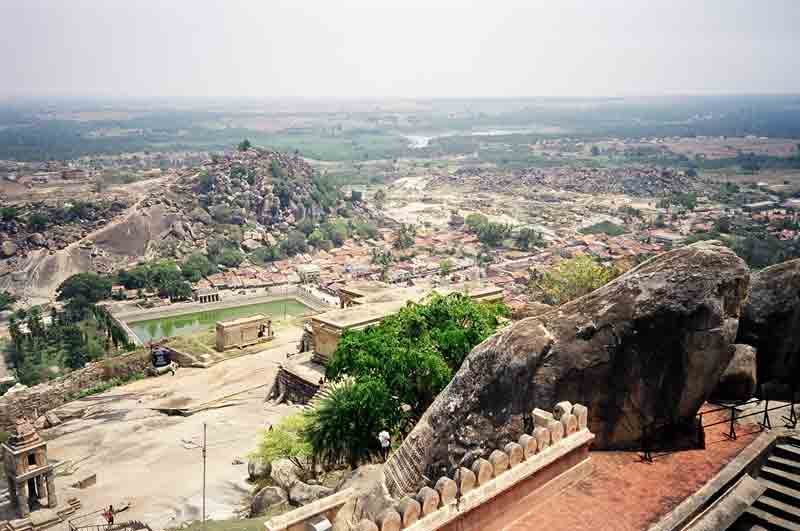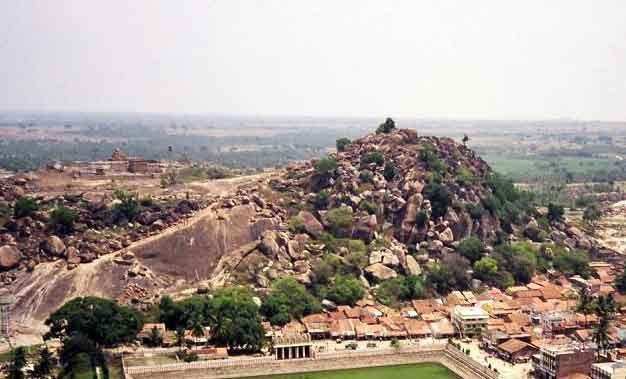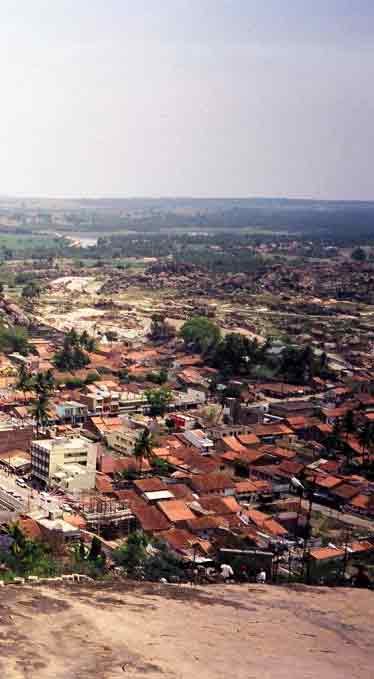ChandragiriChandra Gupta's resting place
The following is an extract from the travel book A River of Life: Travels through Modern India.

It was at Sravanabelagola that Chandragupta, founder of the Mauryan Empire which had ruled from Pataliputra near modern-day Patna, had retired to in his dog days, embracing Jainism and following the Jain practice of the fast to the death, that desperate measure so beloved by Gandhi in times of strife, when he had needed extreme action to command his followers' obedience (Gandhi's main weapon against the British, the nonviolent struggle against oppression, owed much to the Jain principle of ahimsa, non-violence to all living things, with which Gandhi, as a Gujarati, had been intimately familiar). While the statue of Gomateshwara is a little over a millennium old, belonging to the same mediaeval period of India's history as most of the Hindu kingdoms of the South, the Emperor Chandragupta had lived over two millennia ago, in the 4th century BC, giving the town a historical antiquity that had been less evident in the other places I had visited, where such ancient pasts had been eroded by the events of more recent times, the squabbles and petty conquests of minor dynasties whose most ambitious acts were to style their tin-pot regimes as "empires".
I decline the hopeful offers of rickshaw men as I take the short walk to the hill where Chandragupta is said to have died, the eponymous Chandragiri. The hill isn't as big as Indragiri to the north, making the climb to the top, up steps cut into the rock, less arduous, although it is more painful: I am again barefoot; it is later in the day, nearing midday; the rock is scorchingly hot.

The statue of Gomateshwara on Indragiri is still visible from the summit of the second hill, a nub of grey stone perched on the far sweep of dark rock. The steps to the summit of that far hill, a pale line like a mountain river run dry, are speckled with people, Jain pilgrims. Chandragiri is far less popular. There is no one there besides myself, some bothersome boys, a young couple who cross me on the stairs and two chowkidais minding the entrance to the small compound of bastis at the top, small Jain temples as plain and darkly appealing as large tombs in a Christian cemetery. Sanskrit-writ tablets are scattered between the temples like tombstones.

I gaze out over the land beyond the hill. It is bare and rocky, dull but in a pleasant way, a sandy brown streak of colour dotted by dhak and eucalyptus trees and spiked by palms. A lake just below the horizon is reduced to a puddle of water by the distance. There are no people on the far side of the hill, no villages, towns, or roads. Even today, Sravanabelagola is a remote and lonely spot, the perfect retreat for Jain monks. There is a monastery on the outskirts of town, inhabited by members of the digambara or "sky clad" sect, which is to say, they are perpetually naked. The other main sect, the shvetambara or "white clad", are far more prurient in their dress sense, although no less peculiar to western eyes: their monks go everywhere wearing face masks, to avoid inhaling insects, and employ boys with fly whisks to clear a path for them so they don't accidentally tramp on any living thing and so violate their reverence for life.
Looking out over the deserted land below it isn't hard for me to understand why Chandragupta had chosen this spot to retreat from the world. His fast to the death had been prompted by the sorrow he had felt for his famine-stricken people. During the reign of his grandson, Ashoka, the Mauryan empire had stretched almost to the southern tip of the Subcontinent, but even under Chandragupta it had been vast. He was the first emperor to unify most of India under one administration, subduing the country with an army of 600,000 fighting men. After a victorious battle with Seleucus Nicator, the Greek contender to Alexander the Great's Asian empire, the Mauryan kingdom had extended westwards to the borders of Persia. After suing for peace, Seleucus had sent an ambassador to the court of Chandragupta in Patailiputra: one Megasthenes, who was later to describe such people as the Ocypodes, the Enotocoetae, and of course certain mouthless people who sustained themselves by means of vapours.
I try to put myself in Chandragupta's boots, world-weary, enervated by conquests and the rigours of commanding an empire that power-hungry aspirants must have been eager to wrest from him, distraught at the suffering of his millions of subjects as the famine reached it height. The constant clamour of an urban environment and the way it grates on the nerves, a steady attrition, isn't exactly on an equal footing with imperial pressures, but I empathize with the great emperor all the same. For a few hours, I recreate his retreat from the world, relive his solitude and time of deep reflection.
But I am not prepared to go all the way. A fast to the death is most definitely out of the question. Bothered by the stirrings of hunger, I forsake my quiet place away from the world and go in search of a place to have lunch.
Temples etc.
A River of Life
Go back...
Read the previous article about the neighbouring hill of Indragiri.
According to Jain wisdom, we live in an age of decreasing purity, in consequence of which the stature of man is also decreasing. In the time of Adinatha and his son, Gomateshwara, men were giants; hence the often grand scale of depictions of Jain saints and tirthankaras, the crossing makers of the Jain religion, also called jinas, from the Hindi jainas, meaning victors, saviours who have succeeded in crossing over life's stream and making a path for others to follow.

Available for purchase now
Sheldon's account of his overland travels around India, A River of Life, is available for purchase now. Buy the e-book from Amazon.com or Amazon.co.uk, or the paperback from Amazon.com or Amazon.co.uk (also available in other countries, search Amazon for more information).
The first instalment, A River of Life, Book 1: Travels in the North, is available separately (e-book format only) via Amazon.co.uk or Amazon.com. The second instalment, A River of Life, Book 2: A Tour of the South, is available via Amazon.co.uk or Amazon.com.
